This post is also available in: Dansk
With campervan in Norway (part 1)
Cama Coche was to be aired
Cama Coche – our campervan, or the bus as we also call it – was to be aired over the summer of 2022. The question was whether it should go towards sun, heat, and exotic locales that beckoned to the south – or to the north, which beckoned with bright evenings, millions of mosquitoes, and the possibility of rain, sleet, and wind. We chose the latter!
But in order not to just drive around here and there, we considered different destinations. We didn’t have unimaginable amounts of time, so there were limits to how far we wanted to drive. So how is the course set? After a bird, of course, and the holiday’s target species became the parrot of the sea – the Atlantic Puffin!
The closest place from Denmark, where there are really good opportunities to see and experience the Parrot of the Sea – or (Atlantic) Puffin, which is the species’ English name – is on the small Norwegian island of Runde. Here you will find the species’ southernmost Norwegian breeding colony, and that’s where we were going.
Have you read about our experiences with campervans in Pintxos, two campervans, and a Wallcreeper?

Rock carvings and an Olympic ski jumping site
Since the island of Runde lies southwest of Ålesund in Norway, a drive of approx. 1200 km from Copenhagen, we divided it into a few stages. Then there was also time to experience something other than Swedish and Norwegian roads.
UNESCO World Heritage
In Sweden, we visited Tanum’s Hällristininger at Tanumshede in Bohuslän. The area has been designated as a World Heritage Site by UNESCO because of the many rock carvings – or petroglyphs – found in the area. We have been there many years ago, but this time we visited a few other locations, and thus also some other rock carvings. It is always very exciting and interesting to see the pictures that people have cut or scratched on large flat stones thousands of years ago. Read more about Tanums Hällristininger.
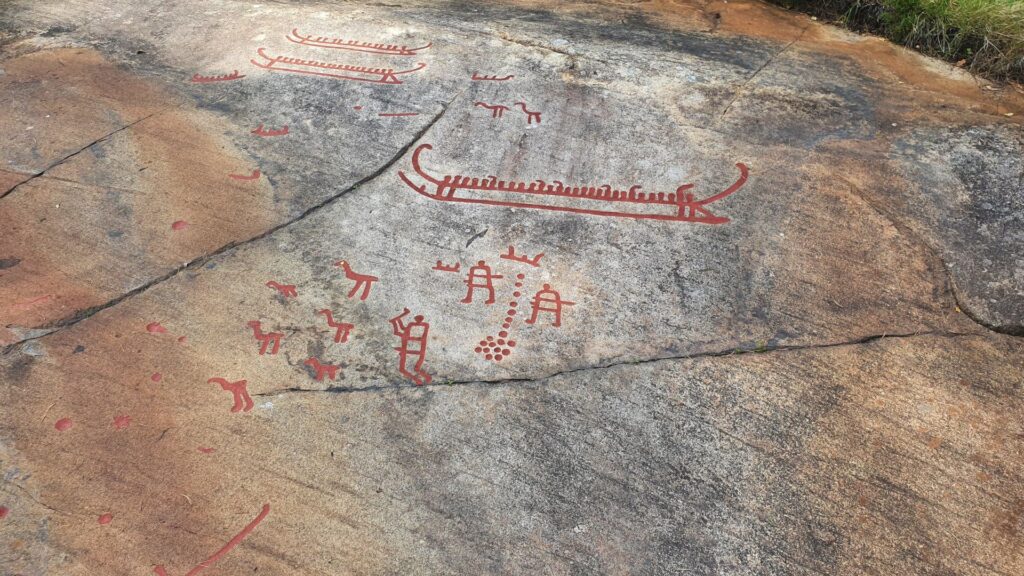
After an overnight stay at a small cozy campsite by Mindesund, a short hour’s drive northeast of Oslo, we continued through Norway. In Norway, there are quite a few toll roads, so it wasn’t just the beautiful Norwegian nature we passed, but also quite a few toll stations. Fortunately, the passage is registered by photographing the car’s number plate, so you don’t have to stop every time. On the other hand, we had no idea how much we would later have to pay!
And now on to the sport
In Lillehammer, it was time for provisions. The city is surrounded by mountains and lies by Norway’s largest lake, Mjøsa. Lillehammer is a popular winter sports venue, and the city hosted the Winter Olympics in 1994 – incidentally the same year that Tanum’s Hällristininger was designated as a world heritage site.
We filled up our stock with, among other things kneipe (bread) and brunost (brown cheese) and took the opportunity to see the Olympic facility, where the ski jumping competitions were held. For those who don’t remember, it was the German Jens Weissflog who then won the Olympic gold on the big hill ahead of Espen Bredesen (Norway) and Andreas Goldberger (Austria). See more ski jumping results from the 1994 Winter Olympics.
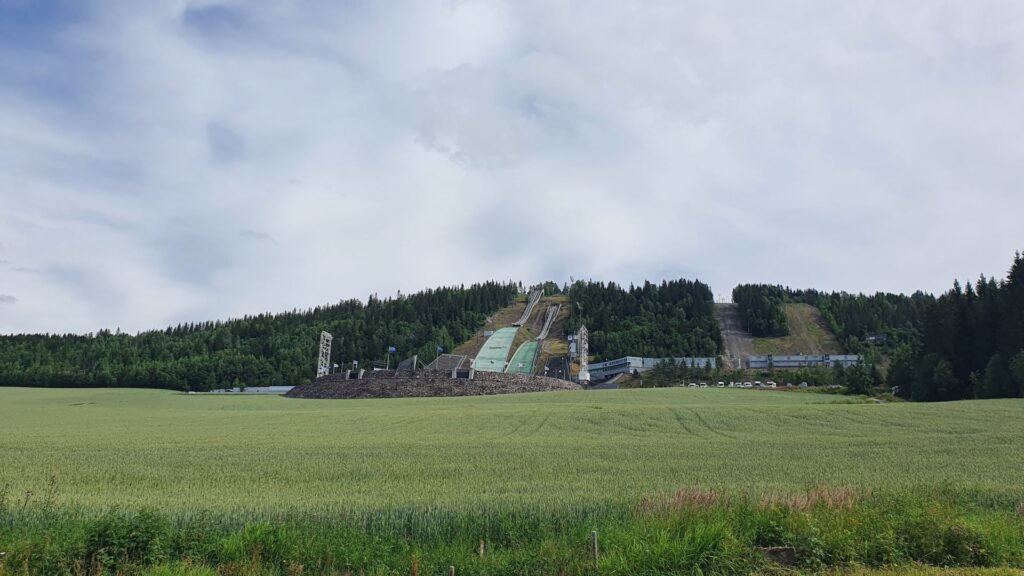
The article continues below this Advertisement
Ålesund
The next morning we arrived fresh and well-rested in the picturesque town of Ålesund in Møre and Romsdal. We had spent the night at the Fjellstova ski hotel east of Ålesund, where they had a nice little place for campervans. The space was considerably smaller than the one we stayed in on the subsequent nights in Ålesund.
Ålesund itself is a small town surrounded by water. But what it lacks in size, it has in coziness and charm. The city is known for its architecture. There are lots of towers, spires and medieval decorations, and pastel-colored buildings. In 1904, most of the city burned down, only to be rebuilt in the Art Nouveau style, which was very popular at the time. Today, you will find several cafes, restaurants, and shops in many of the old buildings. You can also visit the Jugendstil center or the city’s aquarium. You can get more inspiration for Ålesund and Sunnmøre at visitnorway.com.
You mustn’t miss taking the 418 steps from Byparken up to the viewpoint on Mount Aksla, which rises above the city. From the top – approx. 189 m.a.s.l. – there is the most beautiful view of the city and the surrounding fjords and mountains – also called the Alps of Sunnmøre. And if you’re lucky, all the tourists from the cruise ships in the harbor have chosen to do the same.
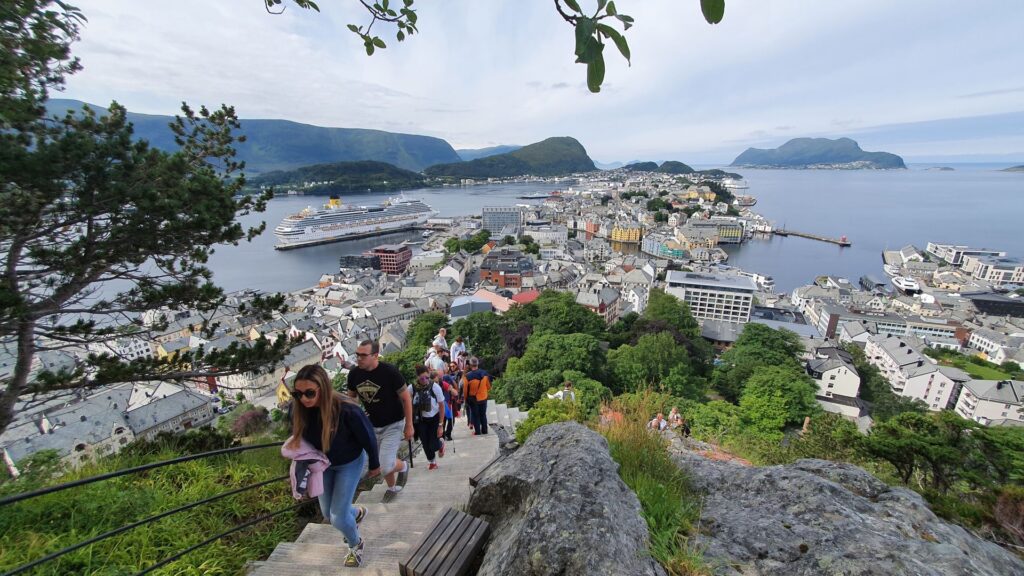
Puffins at Runde
We saw a Puffin at Runde! Actually, we saw many, but exactly how many we don’t know, but there were still thousands at the end of July. There are over 50,000 pairs of seabirds breeding on Runde and a great many of them are puffins.

From Goksøyr Camping, it takes an hour to hike up the island to the seabird colony, where, among other species, Puffins, Common Murres (or Guillemots), and Northern Gannets are breeding. It was cold, and windy with rain showers, but when in the afternoon we saw the first puffins on some rocks below us, it was worth the whole trip. There were many more out on the water, but we had to use the spotting scope to clearly see that many of the “dots” actually were Puffins and not just Murres.

If you really want to experience the puffins, you have to be at the colony in the evening – and at the Lundeura viewpoint, they are more tourist-friendly. They spend the day searching for food out at sea. Just before sunset, thousands of adult birds return from the sea to feed the chicks. Unfortunately, the weather had not improved – on the contrary! During the afternoon it became a lot windier and before long Runde was covered in dark clouds and rain – heavy rain. Up at the mountain, there is nowhere to seek shelter and our umbrellas were not optimal in the wind. It was tough conditions to wait in and as the weather didn’t seem to improve we decided to head back to the campsite and the car.

An evening walk to Lundeura
Fortunately – when we were sitting tired and with sore muscles – and I with an already overloaded knee – the continuous rain stopped. We sensed a slight clearing. We were in doubt if we would be able to hike all the way up again on the same day. But we also knew that we would be upset if we didn’t. And the weather forecast didn’t look promising for the next day either. That’s why we made the trip hike again that evening.
We did not regret that decision. Although we were no less tired and sore when we later could finally lie down to sleep. It was an experience we can definitely recommend – also to non-birders. There were many of them at the colony, as the Puffins are quite a draw. Therefore, in the evening you can also meet a guide, where you can get closest to the Puffins. Besides telling about the birds, the guide also acts as a supervisor. This is to make sure that no one crosses the fence that separates the tourists from the birds. The Puffins are very cute. And having them only a few meters away, it can be tempting to get a selfie with these little birds. To step closer is not safe either. The ground surface is slippery, and there is a very long way to fall down!

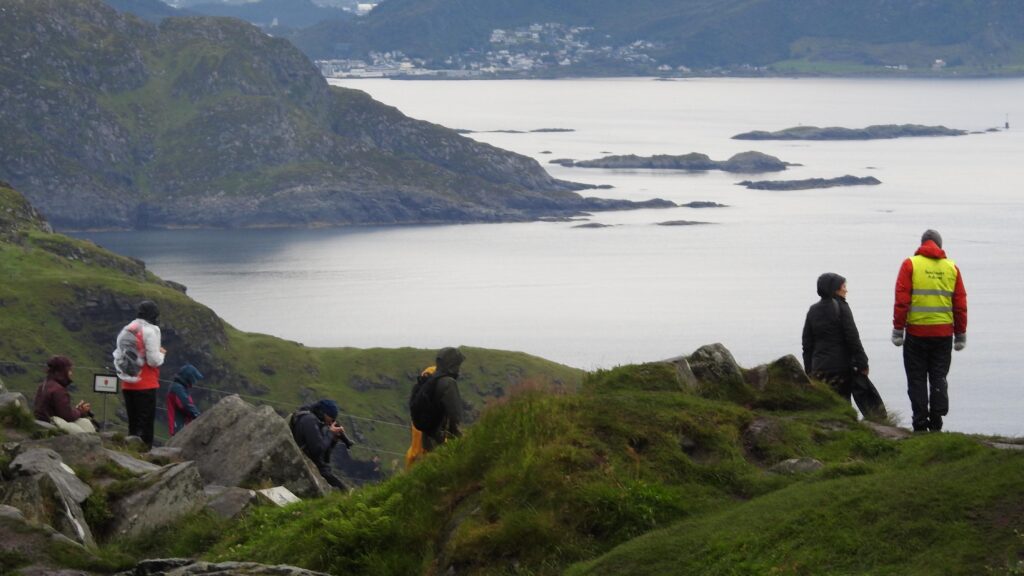
There were already more Puffins in the colony than earlier that day. As the evening progressed even more and more arrived from the sea. There were constant flocks in the air, and we soon gave up trying to count them. We settled for the fact that there were thousands. At the end of the article, you can watch a small video we made of some of the cute and funny Puffins.
The Parrot of the Sea is not a parrot
The bird is actually called Lunde in Danish and Atlantic Puffin in English. The Latin or scientific name is Fratercula arctica. The Puffin is not a parrot, but an auk – i.e. a seabird. Most Scandinavian people probably know it better as Søpapegøje (Sea Parrot). It spends a large part of its life at sea, in the large oceans where its food consists of fish. In other words, something that is far from tropical fruits, nuts, and rainforests, which many people probably associate with real parrots.
When you see the bird in its summer plumage, it is not hard to understand why it has been given the popular name Sea Parrot or Parrot of the Sea. The little bird has a cute and slightly comical look. Its colorful bill, red and black facial markings around the eyes and large pale cheeks, and orange legs and feet. It is probably the brightly colored bill in particular that has given it the nickname, as the colors give associations to colorful parrots. The slightly comical radiance comes from the markings around the eyes, which may remind you of one of the classic clown characters you know from the circus.
You may be lucky to see the sea parrot in Denmark – but it is rare. The best chances are along the west and east coast of Jutland and the north coast of Zealand. Most are seen in spring or autumn as attractive birds. Read more about Atlantic Puffin (in Danish).
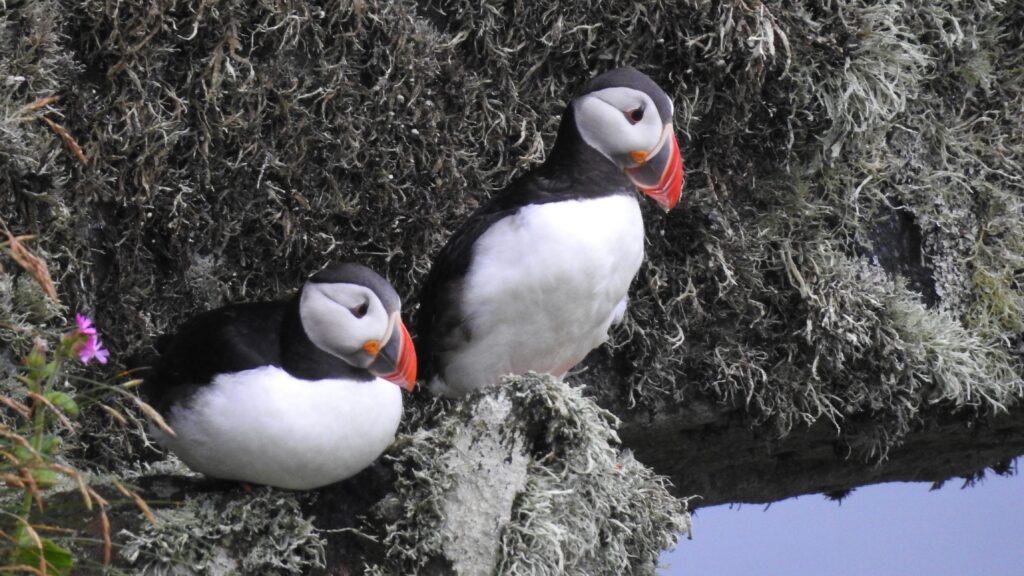

All photos and video © Bente Steffensen & Uffe Damm Andersen, unless otherwise stated.

